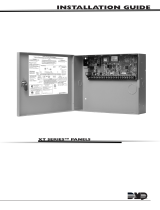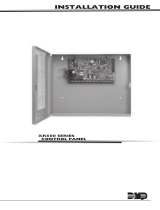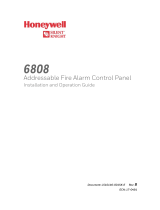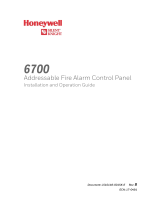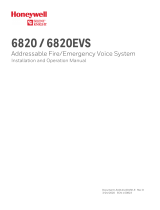
able to detect alarm and wiring fault from the 2-wire loop.
NOTE: If an alarm occurs on the 2W-MOD2 zone before
the 2W–MOD2 has completed its power–up sequence, the
module’s green LED will remain on. To reset this condition,
the system must be reset and the module must be allowed
to complete its power–up sequence.
When using the RRS-MOD with model 2WTA-B, do not mix
the 2WTA-B with other model smoke detectors and dry con-
tact closure devices, including mechanical heat detectors,
manual pull stations and waterflow switches. Such mixing
can cause a direct short on the auxiliary power terminals,
damaging the control panel’s internal circuitry and/or dam-
age devices connected to the initiating device circuit.
EZ Walk Test
The 2W-MOD2 has a push button for EZ Walk Test mode
(see Figure 2.). The EZ Walk Test feature is available 6 min-
utes after power-up or panel reset. If the push button is
pressed momentarily the module will activate EZ Walk Test
for five minutes. All detectors on the loop should enter EZ
Walk Test mode. See i3 detector manual for detector re-
sponse in EZ Walk Test mode.
NOTE: EZ Walk Test cannot be initiated if the Green LED
is not blinking.
If the 2W-MOD2 is in normal condition (Green LED blink-
ing) and pressing the push button does not initiate EZ Walk
Test, wait one minute and try again.
At the end of the five minute period, the module will ter-
minate EZ Walk Test and the yellow LED will stop blink-
ing. The EZ Walk Test period can be extended by pressing
the push button a multiple number of times. For example,
pressing the push button N times will result in a Walk Test
duration of 5*N minutes.
If an alarm occurs during EZ Walk Test, the alarm condition
will supercede EZ Walk Test (alarm is the highest priority).
The EZ Walk Test shall not be used in lieu of functional test-
ing (alarm, trouble and other functional tests) of the system.
If a module or detector fails the test, its wiring should be
checked. If the module still fails, it should be replaced.
Notify the proper authorities when the system is back
in service.
D500-46-00 3 I56-2174-004
Wiring Installation Guidelines
All wiring must be installed in compliance with the Na-
tional Electrical Code, applicable state and local codes, and
any special requirements of the local authority having ju-
risdiction (AHJ).
Proper wire gauges should be used. The conductors used
to connect the module to the alarm control panel, smoke
detectors and accessory devices should be color-coded to
reduce the likelihood of wiring errors. Improper connec-
tions can prevent a system from responding properly in the
event of a fire.
The screw terminals in the mounting base will accept 14-24
gauge wire. For best system performance, all wiring should
be installed in separate grounded conduit; do not mix fire
alarm system wiring in the same conduit as any other elec-
trical wiring. Twisted pair may be used to provide addi-
tional protection against extraneous electrical interference.
Wire connections are made by stripping about 1/4 inch of
insulation from the end of the feed wire, inserting it into
the proper terminal, and tightening the screw to secure the
wire in place.
Installation
Remove power from alarm control unit or initiating device
circuits before installing modules.
After all modules have been installed, notify the proper au-
thorities that the system is in operation.
Testing
NOTE: Before testing, notify the proper authorities that
maintenance is being performed and the system will be
temporarily out of service. Disable the zone or system un-
dergoing maintenance to prevent any unwanted alarms.
Modules must be tested after installation and following pe-
riodic maintenance. Testing should be performed at least
once a year.
Timing at Power-Up or Reset
Two minutes after power-up, the module will check for
communication, high maintenance, low maintenance, and
freeze trouble with each communication spaced 1 minute
apart. If a valid response to the communication check is
received, the module will check for freeze trouble every
4 hours, low and high maintenance every 24 hours, and
will recheck communication every 24 hours. Whenever the
module fails to receive a valid response to the communica-
tion checks, it will verify the result with another commu-
nication check one minute later. If it still fails to receive a
valid response, the module will cease to communicate until
a valid reset from the panel. In this mode, the module is still




